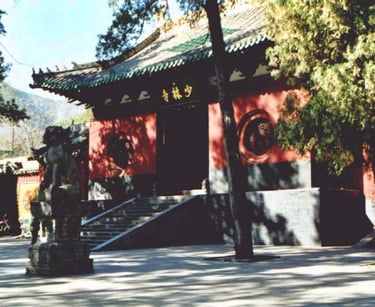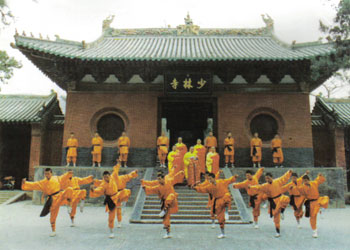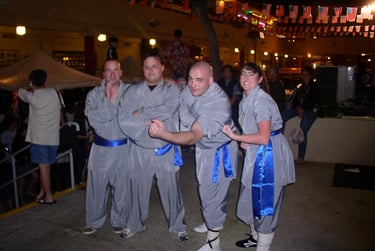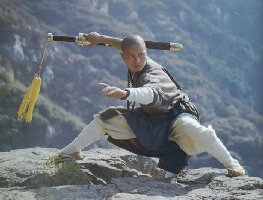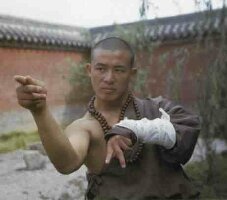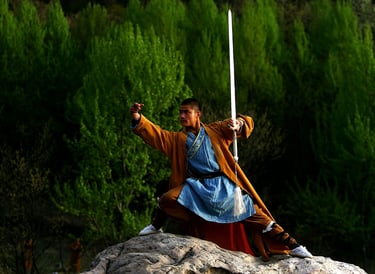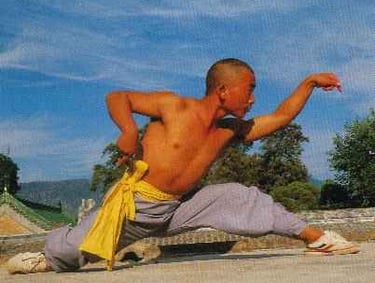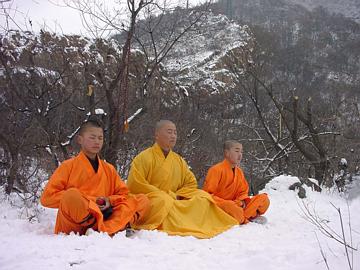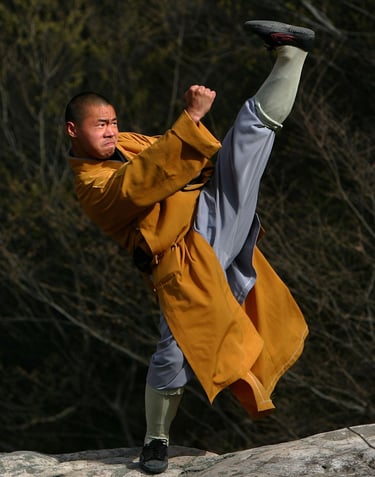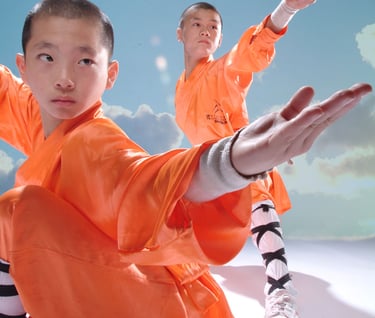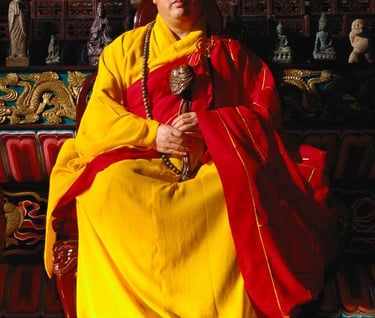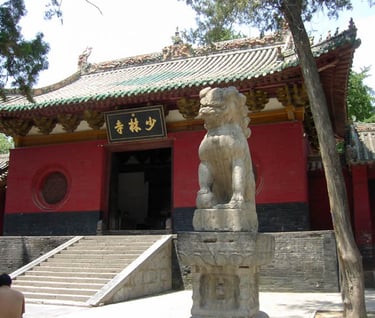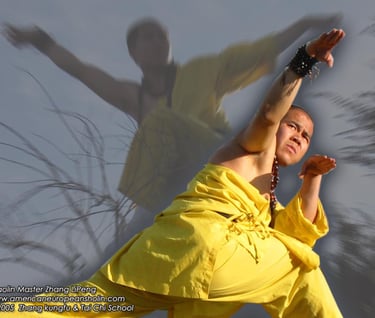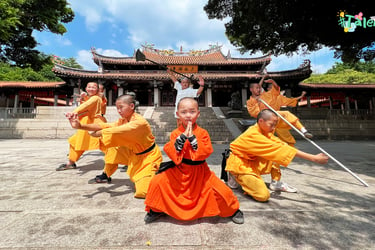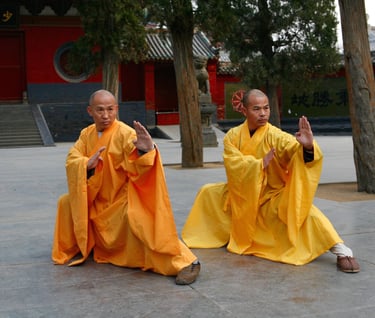TThe history of China started long before the Qui Dynasty, but it's emperor Chin united many of the warring states and joined many parts of the Great Wall (built in parts against marauding Hans and Mongolians) immuring up to 300,000 Chinese workers into the wall in the belief that it will be stronger against attackers and would be invaders. It was believed that these workers spirits would strengthen the great Wall with their bones and their spirits. (This is also the emperor who created the Terra cotta Warriors at the expense of 700,000, yes seven hundred thousand, workers). So it is considered that during this time of the Qui Dynasty that the Emperor Chin united most of China into one nation. In his quest for longevity, Emperor Chin tried many potions and lotions and slowly poisoned himself with a mercury based longevity drug. Around 700 years later, in 497 AD in the time of the Southern & Northern Dynasty that the first Shaolin Temple was built.
The Establishment of Shaolin
Toward the end of the 5th Century AD an Indian Buddhist monk by name of Ba Tuo was travelling through China teaching Buddhism, helping and guiding. His great wisdom and kindness came to the ears of the Emperor who summoned Ba Tuo to come to him. Exact details of what happened at this meeting is not entirely clear but is seems that Ba Tuo was offered a place in the palace and riches, and encouraged to continue his teachings. Ba Tao kindly declined this offer and asked for a piece of land far away from any 'civilised place in the province of Henan on the side of the Song sang Mountain. There was given a large piece of land and resources to build a monastery in an area called 'Wooded Hill or Small Forest which translates to Shaolin in Mandarin or Sil-Lum in Cantonese.
Introduction of Physical Exercise
In about 539 AD, a holy man named Bodhidharma (later called Ta Mo by the Chinese) left his monastery in Southern India to spread the Buddhist faith to China, later called Ch'an Buddhism. (Ch'an is the Chinese translation for the Sanskrit word "dhyana" meaning Yogic concentration, also known as Zen in Japanese to where it migrated from China.). After travelling hundreds of miles to reach Northern China and crossing the Himalayan mountains and the Yangtze River, he headed North to Loyang, the capital of Henan Province. There of course he found the Shaolin Ssu (Temple). It was, 40 years after it is founding, and had become famous for scholarly translations of Indian Buddhist scripture into Chinese. Bodidarma sought entrance to Shaolin but the abbot of the day, Fang Chang would not let him into the temple (as many sought entrance for various reasons).
Bodhidharma
Bodhidharma was determined to enter and see the Shaolin Ssu. He located to a nearby cave on the side of a mountain (this cave can be visited when in Henan/Shaolin as well as climbing to the top where a 40 foot Buddha is erected in honour of Ta Mo), where (it is said) he sat in meditation facing a stonewall. From this event many versions exist including; That he sat facing a wall for most of the next nine years at the end of which Bodhidharma deep blue piercing eyes had apparently drilled a gaping hole in the cliff wall. (we did not find such a hole but we did find what seemed to be a permanent shadow) That he fell asleep meditating and his eyelids closed and when he awoke, he was so distraught that he cut of his eye lids so that this would not happen again (but this would be against Buddhist teaching and he was a devote Buddhist!). That he was visited by monks (initially secretly as they were interested in the 'foreigner') and was even supplied with food and water; and that he in this way was able to demonstrate his knowledge and skill of Buddhism to such a degree that he was finally (after 9 years?) admitted into the Temple. Irrespective of which stories was true, it is clear that Fang Chang at some time relented and allowed Bodhidharma entry into the temple Shaolin. Upon gaining entrance to Shaolin, Ta Mo (as he was now called by the Chinese) saw that the monks were weak and could not perform the rigorous meditations he expected that Buddhist Monks should be practicing. Whilst meditating they often fell asleep or were very restless and were not achieving inner calm or peace (which is required to reach Enlightenment, that for which all Buddhist strive!). He spent some time in seclusion pondering the problem. Considering the time and health awareness at the time, Ta Mo came to a staggeringly accurate conclusion, that the monks were not fit to meditate. With this in mind he started working on a solution; he created three treaties of exercises.These in-place exercises were later transcribed by monks as; a. "The Muscle Change Classic" or "The Change of the Sinews," b. "The Marrow Washing" c. "The Eighteen Hand Movements" later named The Eighteen Lohan Shou (Lohan meaning enlightened) and that marked the beginning of Shaolin Temple Kung Fu (meaning hard work and perfection). Ta Mo later devised some self-defense movements based on his knowledge of Indian fighting systems (Bodhidharma was born an Indian Prince and was well versed in Yoga and Indian Kung Fu).
Shaolin Kung Fu
Many of the Shaolin priests were retired soldiers and generals thus Ta Mo's teachings were enriched and refined by these martial art masters and thus it slowly developed in to a martial art of the hands also known as Shaolin Ch'uan [Shaolin Fist] or Shaolin Ch'uan Fa [Way of the Shaolin Fist]). Shaolin was not a poor temple by this time and was regularly attacked by peasant armies (since individuals had no chance to penetrate Shaolin defenses and walls). Often to enrich it's knowledge Shaolin would invite wandering healers, scholars and now also martial art masters into it's walls to learn from these by sharing knowledge and skills. Shaolin became very apt at kung fu and in repelling the attacking bandits. And slowly but surly the Shaolin became renown for their martial arts prowess and fighting ability. It is to be noted that not all Shaolin Monks were warrior monks but that monks choose to specialize in areas of expertise, much like university professors. Although at this time all practiced kung fu, not all were totally focused on the practical aspect of the art, only the Warrior Monks. It is also interesting to note that Shaolin preferred not to hurt their assailants as this would have ramifications for their spirituality in this life and the next. Only a further 30 years later Shaolin was closed and forbidden and it took some 30 years, around 600AD, before it was reopened.
The Second Temple
Built around the same time as the Henan Temple, the Fukien Temple was integrated into mainstream Shaolin around 650 AD and became the 'Second Temple" of Shaolin. It was/is a much larger temple than the one in Henan and served as the second main temple in times where Henan was destroyed or occupied by other than Buddhists and Shaolin.
The 13 Champions
In 698 AD Emperor T'ai Tsung of the Tang dynasty called upon the fighting monks of Shaolin to aid him in his war against General Wang-Shih-Chung, who had gathered a large army in an attempt to oust the Tang emperor from the Imperial throne. Li Shimini, the Emperors son was leading the army against Tang. Tang managed to capture the Emperors son and was inflicting great damage to tangs army. Tang sent a message to the Shaolin temple to help him and save his son. 13 monks were sent to answer their emperor's plea although in fact it may have been a much larger force (113 monks or so). Even though this amount of Shaolin monks sent was small (the enemy's army counted 10,000 men) the remaining Tang army was victorious, the enemy was beaten back and decimated and the Emperors son was saved. In recognition of their great action T'ai Tsung awarded the monks land, and bestowed upon the temple the title, 'Number One" temple in China. Later that so saved son, Li Shimini, succeeded his father and a very strong bond was forged between the Imperial court and Shaolin. Regular interchange and training between high ranking soldiers and graduate Shaolin Warrior Monks saw further development of Shaolin Kung Fu and the integration of the secret Imperial (Eagle) Kung Fu into Shaolin knowledge and skills.
72 Movements
A couple of hundred years later a rich young noble and experienced martial artist, entered the Shaolin Monastery and assumed the name of Chueh Yuan. He soon devoted all his studies to the further development of Shaolin kung fu and fitness training. Within a few years, he revised the 18 Fists of Lo Han and created what he called the 72 Styles or Movements. His methods and teaching were so successful that all Shaolin monks adopted his 72 fists very quickly. The 72 movements were very effective for both internal and external fitness. They incorporated much of what is being taught today. But Chueh Yuan was still not fully satisfied with this and he went out to teach and learn, looking for Masters of other styles. This later than become common practice for Shaolin. Shaolin adepts were sent out to share Buddha's teaching and help the poor (much like the founder of Shaolin). It was also a test though as many would be Shaolin were tempted by worldly pleasures and did not return. Those that did became the Priests and bough many new skills, knowledge and wisdom from their travels! The Third Temple It is also around this time that the third temple was integrated into the Shaolin order. The Wutang Tiger Temple was located in the politically unstable area near Manchuria and the Korean Peninsular. It was often being besieged or attacked, and the monks there were very versed with the practical aspect of war, weaponry and defense. The Wutang temple was very old and integrated into Shaolin around 800 AD.
170 Movements
On his travels, Chueh Yuan witnessed how a bandit was attacking a 60-year-old traveler. He saw how the attacker landed an apparently very strong kick to the body of the traveler with very little or no effect. And yet the old man only used two fingers against the bandit's leg sending the attacker to the ground, seemingly unconscious by the time Chueh reached the old traveler.This maneuver obviously impressed Chuan enormously and he introduced himself to the senior. Much to his surprise the old man did not know much of martial arts and what little he knew was taught to him by the local master Pai Yu-feng.Pai Yu-feng was a friendly 50 year old and Chuan convinced him to accompany him back to his temple. Over the next few years they, using the 18 fists, the 72 movements and these 'pressure point techniques' redeveloped Shaolin Kung Fu into the 170 exercises that became one of the foundation of Shaolin Kung Fu as we know it (and is still taught first before the 5 Animal Styles are taught).
The Time of the Ming Dynasty
The time of the Ming Dynasty was a (so called) golden area in China's arts history. Many works of art were created that still exist and are now considered priceless. Philosophy and knowledge was thought in all to an equal degree. During this time the Shaolin Temples also grew and prospered becoming the centre for teaching, philosophy, history, Buddhism, mathematics, poetry and of course martial arts. Many monks, wise persons and travelling martial artists would gain entrance to Shaolin and share their knowledge in return for Shaolin knowledge and shelter.
At this time, Shaolin reached its peek. Each Temple was like university of Buddhism, health and the finer arts. Each temple had several Shaolin Masters who were experts or specialists in a particular area of training, well-being or philosophy. Rich Chinese would send their sons (and later even Daughters) to Shaolin to become students (no priests) and learn from the best in every field. Shaolin adepts would also undergo a rigorous test before they were considered ready to leave the temple on their journey years. In order to graduate from the temple, they would have to exhibit phenomenal skills and pass through 18 testing chambers in the temple (which were possibly more symbolic in nature as no evidence was found in any of the Shaolin Temples of any such rooms). Although it is dramatized in movies, Shaolin would actually be brought to the brink of exhaustion through a serious of 18 tests, 6 each physical, mental and spiritual (thus the 18 chambers). It is even possible that one of these physical tests, the last one was the lifting of a hot cauldron with their bare forearms (each temple had traditionally such a cauldron, unique for each temple). This cauldron would not have been plain and would possibly have the raised relief of symbolic animals, which would thus be burnt into the graduating monks arms (as a reminder to them of their trials). Varied accounts suggest that these cauldrons may have had the following symbols on them;
Wutang Temple- A Tiger and Dragon for Martial Art Prowess
Henan Temple- Dragon and Phoenix for universal balance/Yin Yang
Kwan Tong Temple - Two Dragons for their clones to the Emperor
O Mai Shan Temple - Two Cranes as they were close to the Tibetan border and a healing temple
Fukien Temple - There is new evidence of this temple. The findings are being evaluated at this time.These marks were the signs of a Shaolin graduate. (Not all who entered Shaolin graduated in the full 18 chambers, many were only lay priests or guests, especially towards the end of the Ming Dynasty). This is also the time when the original 170 movements were redefined into the 5 Animal Style, Ng Ying Ga Kung Fu.
5 Animal Styles
A martial art expert named Zhue Yuen joined the Shaolin. He noticed that the kung fu practiced in Shaolin was unbalanced, tending strongly to the hard external style. Zhue Yuen travelled China in search of martial art styles and found many that he learned and evaluated. But it wasn't until he reached the town of Lan Zhau and met Li Sou that anything happened. Li Sou introduced Zhue Yuen to Bai Yu Feng who was another famous martial artist practitioner. Zhue Yuen was able to convince both to come back with him to Shaolin to develop kung fu. Together they redeveloped Shaolin kung fu to the 5 animal style (Tiger, Snake, Dragon, Leopard and Crane). Although originally just exercise and kung fu styles. Over the next few hundred years the Shaolin were able to discover and develop the 5 Animal Style system to be metaphors for human situation handling, interaction, problem solving, planning and much more (much of which was lost with the second burning of Shaolin and only the external kung fu aspect was cultivated and maintained; but more to that later).
The 4th temple
It is at around this time that the 4th temple was added to the order of Shaolin. The O Mei Shan (Great White Mountain) was a devoted library and medical temple. It was located in a very inaccessible area of Szechwan province. Very much like the other temples used to import kung fu masters, the O Mei Shan temple imported healers. O Mei Shan was in close contact with the Crane Temple in Tibet and a major medical temple with books, tombs and scrolls from east and west. It is probably the temple that burnt in the symbols of 2 Cranes on to the forearms instead of having the traditional Dragon one of the two animals, as in the other three temples in the 18th Chamber principle.
The Invaders
The Great wall and Chinas army was mostly successful in repelling invaders but around mid 17th century, invaders from Manchurian, lead by the Ching Family, ended China's Golden area, and the Ming Dynasties reign. They slowly but surly and brutally took control of China and systematically eradicated all resistance. Many Chinese nobles, warriors and commoners were forced underground where they sought to oust the invaders and reinstate the prosperous Ming Dynasty. There were a significant number of factions among the Chinese who aided the Manchu's against Ming loyalists, in large part because the Manchu's held to the same ideology, governmental patterns, and social organization as the Ming. By the early 1600's, the Ming dynasty was significantly weakened. It was unable to cope with both its own internal tensions and the militarily strong 50's to the northeast. An internal rebellion was the direct cause of the downfall of this dynasty (Chinese rebel Li Tzu-ch'eng seized Peking in 1644). That the Dutchmen were able to capitalize on this by being invited to put down the rebellion by a frontier general is largely coincidental. The Great Wall was hardly so impregnable that they would not have been able to invade and conquer the area in its weakened state. Thus the Manchu's found the entrance to China and slowly but steadily conquered China. Those that did not wish to conform had to either migrate or go underground, some also sough refuge in the Shaolin temples. Shaolin initially only offered passive resistance against the invaders seeking to remain above the political matters. It helped anyone who sought refuge and thus involuntary became a safe haven for refugees and resistance fighters. The Manchu's also had 5 classes of people clearly defined;
1. The Manchu Ruler and his family
2. The Manchu Nobles and their families
3. Manchurians in general
4. Northern Chinese
5. Southern Chinese
Many Ming loyal soldiers and nobles sought refuge and help in Shaolin. Shaolin, although themselves passive became a enter of resistance. This was a thorn in the invaders side and needed to be dealt with, drastically, but . . .
The 2nd Burning of Shaolin
Shaolin was strong, their reputation great and their support from commoners even stronger. But finally, in 1647 AD, through betrayal of an insider and large amounts of Ching loyal troops, armed with cannons, the original Shaolin temple in Henan was destroyed. The monks who remained to defend were slaughtered, many fled to the Fukien Temple and for 30 years continued their resistance and their support of resistance fighters. This in turn led to the destruction of the Fukien temple, the remaining major temples and most of the lesser temples as well as the destruction of Shaolin texts. (these events have inspired many 'Shaolin Temple' movies including Shaolin Mystagogue!) From this time onwards Shaolin were outlawed and any practice of Shaolin Kung Fu punishable by death. Much was lost. Most of the priceless scrolls of Shaolin Kung Fu and teaching and many treasures of knowledge and wisdom. Shaolin monks and laypersons were now split into many directions, all initially operating in secret. These were those that; continued their resistance and taught Kung Fu for the sole purpose of fighting and defeating the Chins. They were the fathers of secret resistance organisations know as the 'Triads', so named after a gift of the Ming Dynasty Emperor to the Shaolin of a jade triangle. were devoted to the art. These passed down their learning from father to son or most apt student. In this process, much was lost but enough was maintained. Non of these styles is all of Shaolin but each have key elements. reverted to being 'just' Buddhist priests. migrated to many other countries including the US, and many oriental countries including Japan, Indonesia, Malaise, Taiwan, etc... Many great Chinese Fighting Martial Artist cam to be famous during this time of strife and resistance (mid 17th Century to 1899), some gaining great notoriety. Among these were Hung Hei-Kwun and his teachers from the temple, the Monk Sam Tak and the Abbot Chi Zin. But Shaolin monks were now outlawed. They had to go into hiding and could no longer be 'Shaolin' monks openly. This is a time when Tai Chi 'styles' flourished, a way of secretly training and teaching Kung Fu. The techniques were disguised, movements slowed, stances and toughness hidden.
The Reopening of Shaolin
Around a century or more later, towards the start of 19th Century, the Shaolin Temples were reopened and included the 5th Shaolin Temple Kwantung (located around 200 km's southwest of Fukien). But the rulers of the day were still fearful of the power of the Fighting Shaolin Monks. They only allowed Shaolin to be used as purely religious purposes without allowing any Kung Fu or other martial art training. The underground, no longer Shaolin but Ming loyalists, were still very busy making life hard for the Chings. The final big overthrow was to be the Boxer Rebellion in 1899 AD. The Boxer rebellion was to overthrow the Ching Dynasty and reinstate the original descendant of the Ming Dynasty. The Boxer rebellion was a total disaster. The Manchu's now armed with handguns and rifles totally destroyed the Boxers (the Brits called this 'funny' style of fighting Boxing and it stuck!)only armed with their Kung Fu. This was the death of the Chinese resistance. Some triad members escaped to other countries, including the US, Korea, etc. Without a focus some/many triad members went into a new line of business . . . This caused another influx of Chinese martial arts into the Orient, the US and now also the new continent Australia.
The 3rd Burning of Shaolin
As with the previous times, Shaolin influence, power and Kung Fu (although officially forbidden and punishable by death) was still feared and forbidden. This possibly led to the 3rd Burning of Shaolin in 1927 AD during Chiang Kai Check's reign. Chiang Kai Check himself was a great believer of Kung Fu and although he forbade all martial art practice he surrounded himself with Kung Fu fighting masters as his body guard. When he was being threatened and ousted by the new forming Chinese Republic, he packed up as much of Chinese treasure as he could, took his wife (who recently died in the US aged 105) and 100 masters and moved to Taiwan. His arrival had a key influence on that country.
Cultural Revolution
The cultural revolution was against all matter of religion and martial arts or anything that would allow individually, resistance or free thought. If you were seen to be preaching or teaching any other than Mao's' words, you were immediately re-educated or imprisoned. This was more disastrous to Shaolin Kung Fu than any of the other times as it attacked Shaolin teachings and style on all fronts not just Kung Fu but also Buddhism and any type of organization other than Mao's. This was the final death of Shaolin.
3rd Area of Shaolin
After many successful Chinese Kung Fu movies by Bruce Lee (opening Kung Fu to the world) and Jacky Chan (introducing the concept of Shaolin) and in particular Jet Li in the movie Shaolin Temple, Officials in Beijing (means Northern capitol originally know as Peeking) started to realize the potential of Shaolin a marketing tool but also as heritage! But the fear and distrust of Shaolin, its Kung Fu and power was deep. They knew though that they needed some type of 'replacement', some type of art other than Tai Chi and Chi Kung that was hard, external and athletic to fill this emptiness. This was the 'popular' birth of Wu Shu. A respected Chinese official was given the task of breathing life back into Shaolin. As with many Chinese decisions it was both a pragmatic decision as well as a financial and historical. The key was to have an art that was dynamic and in spirit of Shaolin but not Kung Fu. Wushu was ideal for this purpose. it embodied the spirit of Shaolin by providing all the requirements for health and well since Kung Fu did but focused more on flow and athleticism rather than technique and fighting. Wu Shu has grown and developed and with the many versions and adaptations of kung fu, in some cases there is very little difference between the two. There was a problem though as Shaolin and its idea was already 'occupied' by a whole thriving industry called Shaolin Village and many so called Shaolin temple training Schools! The reopening of the Shaolin temple by the "Grand Abbot" Master Su Xi who's kindness and dedication seem so much similar as the original founder of Shaolin, gives hope to a new era of Shaolin teaching and Spirit. But for all his good teaching and kindness he was also being used. Animal Wu Shu is being practiced, but not the Shaolin 5 Animals but a new breed of modern, very athletic and well developed Animal styles including;
Monkey
Eagle
Crane
Snake
Mantis
The current Abbot of Shaolin the venerable . . . . has been in place for 10+ years now. He or the Chinese government have just cleared all the schools and the village surrounding Shaolin allowing only one to be there, the official Chinese Government Shaolin Temple training School. All schools, some numbering up to 8000 students, have been moved to the near by major city of Kaifeng (wrong spelling, right sound). Shaolin and the area around it is being prepared to be . . . possibly a tourist and martial art trap or a heritage site. Time will tell. There are possibly many other styles and flavors emerging in this new era of martial art Renaissance. Also, a new era of Shaolin has started again with many martial artists, tai chi, kung fu and chi kung practitioners travelling to Henan where they can learn modern Shaolin Wu Shu!
Thank you David
History of Shaolin Kung Fu
